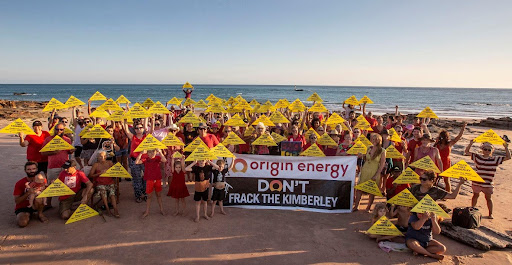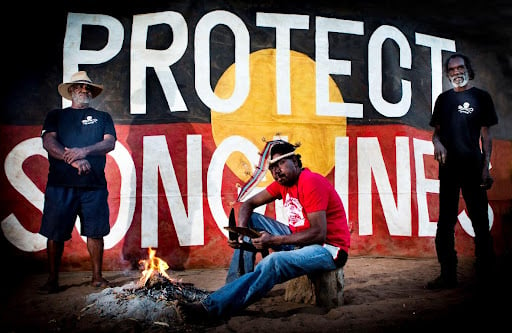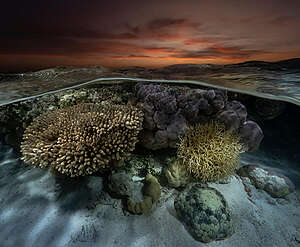With birthing grounds of the largest Humpback Whale population, corals and fish to match the Great Barrier Reef, the Kimberley is like nowhere else on Earth. Despite its international significance it’s still not safe from the fossil fuel industry.

Ten years ago, Western Australian company Woodside Energy and its joint venture partners exited a planned $80 billion Browse LNG project at Walmadany (James Price Point). It took one of the biggest most effective environmental campaigns in Australia’s history to win. Traditional Custodians and the local community, with national and international support, protected the Kimberley coast from the world’s biggest gas refineries and ensuing industrialisation.
Walmadany, with its endangered monsoon vine thickets, turtle nesting beaches, bilbies, and the world’s biggest fossilised dinosaur footprints, was saved. Its numerous shell middens, songlines, burial sites and priceless Aboriginal heritage, were shielded from 30km² of concrete and the adjacent ocean was defended from becoming a 50km² ‘deadzone’ as described in the government’s own reports.

‘Protect Songlines’ – a plea from Traditional Custodians Phillip Roe, Eric Hunter and Richard Hunter © Damian Kelly
Ten years later and the fossil fuel industry is back, determined to burn every last molecule of methane, regardless of the cost to our climate and risks and damage to the world’s top natural refuges.
I’ve been here before. The fossil fuel industry will stop at nothing to make obscene profits, regardless of the damage to ecosystems, water reserves and climate. We have no choice; we must keep fighting together until the region is protected.
The new fight is to stop the Kimberley’s world-renowned landscapes from being turned into a fracking hell. Oil and gas companies are wanting to build vast gas fields on land in the Kimberley’s Canning Basin, requiring thousands of wells to feed an export pipeline. Buru Energy is flagging a floating LNG facility in the National Heritage-listed King Sound – a vast expanse of water last stronghold of the critically endangered freshwater sawfish, fringed with mangrove systems and rich mudflats supporting saltwater crocodiles and. The Martuwarra Fitzroy, a National Heritage listed river, flows into King Sound, creating a rich ecosystem with one of the highest tides in the world.

Oil and gas exploration well pad encroaching on the King Sound mangrove system © Damian Kelly
If fracking went ahead, the carbon pollution could be more than Australia’s Paris Agreement carbon budget for energy twice over. The Kimberley conservation community has been holding back the tide of fracking by raising awareness, leading protests, lobbying government, sending tens of thousands of submissions to the Environment Protection Authority and holding industry to account.
Woodside and its joint venture partners, with BP the biggest backer, is again out in the Browse Basin, focusing on drilling around the Scott Reef, 400km of the Kimberley coast. This time they want to pipe the gas, which has a high CO2 content, to the Pilbara to process at existing facilities. The gas factory would trigger a carbon bomb of six billion tonnes of CO2 over its lifetime. An oil spill would devastate Scott Reef and threaten the Pygmy Whales who travel here annually.
The Rainbow Warrior, which visited Broome to support the ‘Whales not Woodside’ campaign, was warmly welcomed by Kimberley locals, who came onboard, to keep Browse Basin gas in the ground and to stop fracking in the Kimberley.
Having the Rainbow Warrior here and sharing information about our campaigns in the Kimberley and offshore, and hearing the Traditional Owners’ concerns about climate change, was an event that energised us all. A decade ago, the Kimberley community rallied to shut down Woodside’s proposed Browse LNG gas terminal at James Price Point. We won.
Now, we are ready to show a force of strength again against Buru Energy, and let them know the community is behind us, and we wont stand for their new plans.
By Martin Pritchard – Director of Strategy, Environs Kimberley


